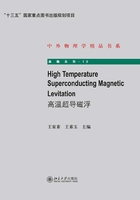
1.6 Penetration depth
The London penetration depths λL describes the distance to which the magnetic flux penetrates into the superconductor from the surface between air and metal.For the special case of a semi infinite superconductor with a flat boundary within free space, if the magnetic field outside the superconductor is constant and parallel to the superconducting boundary plane, the differential equation(1.5.11)becomes one-dimensional with a solution

where B(0)is the magnetic field at the surface of the superconductor. Here we see that when a magnetic field is present, superconducting currents are induced to shield the magnetic field in the interior of a superconductor.The physical meaning of the London penetration depth λL can easily be understood.
Thus, the London equations imply a characteristic length scale λL over which external magnetic field is exponentially suppressed.

where λL (0)is the penetration depth at the absolute zero and is one of the inher ent characteristic parameters of a superconductor.According to the temperature dependence of the density of superconducting electrons in the two-fluid model, the penetration depth depends on temperature(BCS calculation also gives a similar relationship)as shown below,

where t=T/Tc . Close to Tc , λL tends to infinity, and at a temperature very close to Tc ,Eq(1.6.3)can be expressed as

It should be noted that for superconductors in the superconducting state the field can only penetrate into the superconductor by a penetration depth λL for both dc and ac magnetic fields.For superconductors in the normal state, there is no penetration depth, namely the magnetic field cannot be shielded.